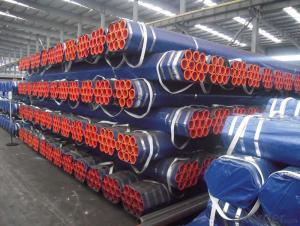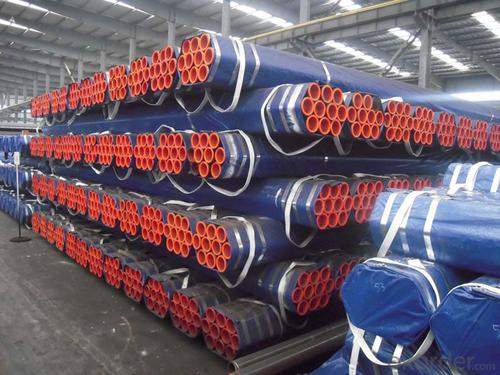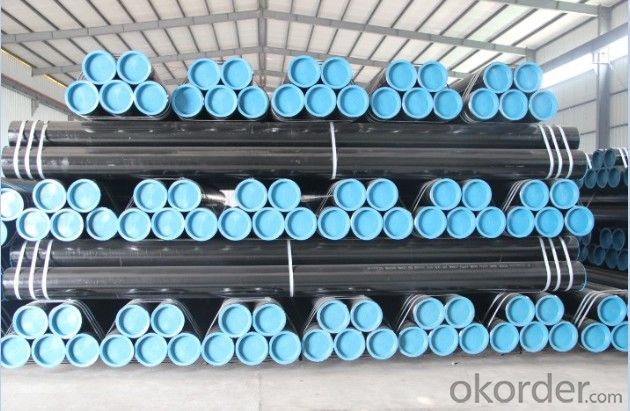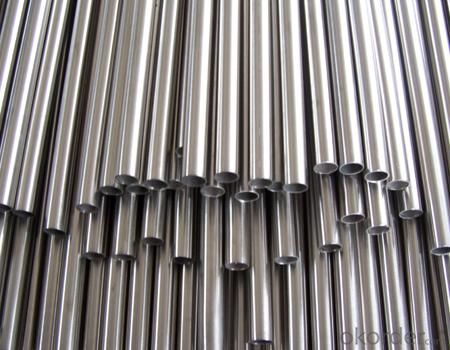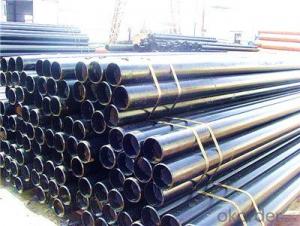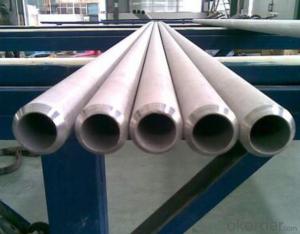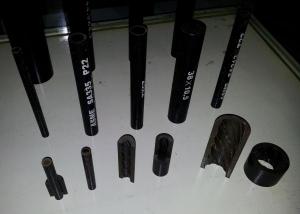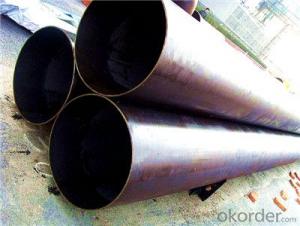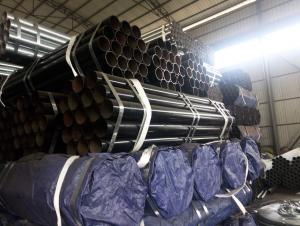The Steel tube -- Seamless tube pipe production
- Loading Port:
- Tianjin
- Payment Terms:
- TT OR LC
- Min Order Qty:
- 25 m.t.
- Supply Capability:
- 10000 m.t./month
OKorder Service Pledge
OKorder Financial Service
You Might Also Like
1、Structure of Seamless tube ASTM A106/53:
Seamless pipe is formed by drawing a solid billet over a piercing rod to create the hollow shell. As the manufacturing process does not include any welding, seamless pipes are perceived to be stronger and more reliable. Historically seamless pipe was regarded as withstanding pressure better than other types, and we are trying to provide best service what we can, and we produce any pipe and to meet silent's demand just like API 5L, API 5CT, ASTM A106/A53 serious and etc.
2、Main Features of the Seamless tube ASTM A106/53:
• High manufacturing accuracy
• High strength
• Small inertia resistance
3、Seamless tube ASTM A106/53 Specification:
Standard | GB, DIN, ASTM ASTM A106-2006, ASTM A53-2007 |
The Grade | 10#-45#, 16Mn 10#, 20#, 45#, 16Mn |
Thickness | 8 - 33 mm |
Section Shape | Round |
Outer Diameter | 133 - 219 mm |
Place of Origin | Shandong, China (Mainland) |
Secondary Or Not | Non-secondary |
The Application | Hydraulic Pipe |
The Technique | Cold Drawn |
The Certification | API |
Surface Treatment | factory state or painted black |
Special Pipe | API Pipe |
Alloy Or Not | Non-alloy |
Length | 5-12M |
Outer Diameter | 21.3-610mm |
Grade | 20#, 45#, Q345, API J55, API K55, API L80, API N80, API P110, A53B |
Standard | ASME, ASTM |
1) Material: 20#(ASTM A 106/A53 GRB.API5LGRB,GB),45#,16Mn,10#.
2) Specification range:OD: 21.3-610mm,WT:6-70mm,length:6-12m or according to the requirement of clients.
3) Excutive standards: GB,ASME API5L.ASTM A 106/A53,Despite of the above standards,we can also supply seamless steel pipe with standard of DIN,JIS,and so on,and also develop new products according to the requirements of our clients!
4) Surface: black lacquered,varnish coating or galvanized.
5) Ends: Beveled or square cut,plastic capped,painted.
6) Packing: bundles wrapped with strong steel strip,seaworthy packing.
4、Packaging & Delivery
Packaging Details: | seaworthy package,bundles wrapped with strong steel strip |
Delivery Detail: | About 15-30 days after received 30%TT |
5、FAQ of Seamless tube ASTM A106/53:
①How is the quality of your products?
Our products are manufactured strictly according to national and internaional standard, and we take a test
on every pipe before delivered out. If you want see our quality certifications and all kinds of testing report, please just ask us for it.
Guaranteed: If products’ quality don’t accord to discription as we give or the promise before you place order, we promise 100% refund.
②How about price?
Yes, we are factory and we can give you best price in the market, and we also have an honest business attitude, we quote as lowest as possible for any customer, and discount can be given according to quantity”,if you like bargain and factory price is not low enough as you think, just don’t waste your time.Please trust the quotation we would give you, it is professional one.
③Why should you chose us?
Chose happens because of quality, We can give you both.Additionally, we can also offer professional products inquiry, products knowledge train(for agents), smooth goods delivery, exellent customer solution proposals.Our service formula: good quality+good price+good service=customer’s trust.
SGS test is available, customer inspection before shipping is welcome, third party inspection is no problem. Trying to be No.1 supplier is what we are dioing.
6、Seamless tube ASTM A106/53 Images:

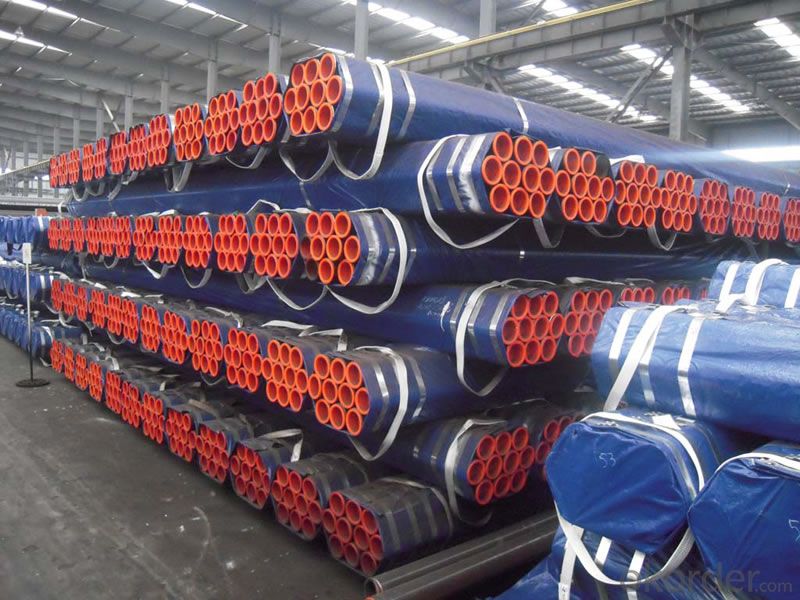
- Q: What is the difference between nominal and actual pipe size?
- Nominal pipe size refers to the designation used to identify the approximate inside diameter of a pipe, while actual pipe size refers to the measured inside diameter of a pipe. The nominal size is a standardized value, whereas the actual size may vary slightly due to manufacturing tolerances.
- Q: Can steel pipes be used for the construction of high-rise buildings?
- Yes, steel pipes can be used for the construction of high-rise buildings. Steel pipes are commonly used in the construction industry due to their strength, durability, and ability to withstand high pressure and heavy loads. They are often used in the structural framework of high-rise buildings to provide structural support and stability. Additionally, steel pipes can be easily fabricated and installed, making them a suitable choice for constructing tall and complex structures.
- Q: How are steel pipes threaded?
- Steel pipes can be threaded using a process called threading. Threading is the process of creating screw-like grooves on the outer surface of the pipe, which allows it to be connected to other pipes or fittings using threaded connections. There are several methods for threading steel pipes, including manual threading, electric threading machines, and hydraulic threading machines. In manual threading, a handheld pipe threading tool called a die is used. The die is placed on the outside of the pipe, and the pipe is rotated while pressure is applied to create the threads. This method is suitable for small diameter pipes and is typically used for on-site repairs or in small-scale operations. Electric threading machines are commonly used for larger diameter pipes. These machines consist of a motor-driven spindle, which rotates the pipe, and a die head that holds the threading dies. The operator simply feeds the pipe into the machine, and the threading dies cut the threads onto the pipe automatically. Hydraulic threading machines are similar to electric threading machines but use hydraulic power to rotate the pipe and create the threads. These machines are typically used for larger diameter pipes or in heavy-duty applications. Regardless of the method used, it is important to ensure that the pipe is properly prepared before threading. This may involve cleaning the pipe, removing any burrs or sharp edges, and applying a lubricant to reduce friction during the threading process. Overall, threading is a common and efficient method for creating threaded connections on steel pipes. It allows for easy assembly and disassembly of pipes and fittings, making it a popular choice in various industries such as plumbing, construction, and oil and gas.
- Q: How are steel pipes used in the construction of chemical plants?
- Steel pipes are commonly used in the construction of chemical plants for various purposes. They are primarily utilized for transporting fluids and gases, such as chemicals, water, and steam, throughout the facility. These pipes are selected for their durability, strength, and resistance to corrosion, which is crucial in an environment where exposure to harsh chemicals is common. Steel pipes are also used for structural support, such as in the construction of platforms, walkways, and pipe racks. Additionally, they can be employed for ventilation and exhaust systems, as well as for fire protection systems in chemical plants. Overall, steel pipes play a vital role in ensuring the safe and efficient operation of chemical plants.
- Q: Can steel pipes be used for desalination plants?
- Yes, steel pipes can be used for desalination plants. Steel is often chosen for its high strength, durability, and resistance to corrosion, making it suitable for carrying and transporting the highly saline water used in desalination processes. Additionally, steel pipes can handle high pressure, ensuring efficient water flow throughout the plant.
- Q: How do you calculate the deflection of a steel pipe?
- To calculate the deflection of a steel pipe, you can use the formula for beam deflection, which takes into account the pipe's dimensions, material properties, and applied load. The specific equation you would use depends on the type of loading and support conditions. However, generally, you would need to determine the moment of inertia of the pipe cross-section, the modulus of elasticity of the steel, and the applied load to calculate the deflection.
- Q: What are the different types of pipe fittings used with steel pipes?
- There are several types of pipe fittings commonly used with steel pipes, including elbows, tees, reducers, flanges, couplings, and unions.
- Q: Can steel pipes be used for conveying gases?
- Yes, steel pipes can be used for conveying gases. Steel pipes are widely used in industrial applications for transporting various gases, including natural gas, propane, and other types of gases. Steel pipes have excellent strength and durability, making them suitable for carrying gases at high pressures and temperatures. Additionally, steel pipes have a high resistance to corrosion, which is crucial when dealing with gases that can be corrosive.
- Q: Can steel pipes be used for sewage systems?
- Yes, steel pipes can be used for sewage systems. Steel pipes are commonly used in sewage systems for their durability, strength, and resistance to corrosion. They are suitable for transporting sewage and wastewater, ensuring reliable and long-lasting performance.
- Q: Can steel pipes be used for bridge construction?
- Yes, steel pipes can be used for bridge construction. Steel pipes are commonly used in bridge construction due to their high strength-to-weight ratio, durability, and ability to withstand heavy loads and harsh environmental conditions. They are often used for constructing bridge piers, supporting structures, and for carrying utilities such as water or gas pipelines across the bridge.
Send your message to us
The Steel tube -- Seamless tube pipe production
- Loading Port:
- Tianjin
- Payment Terms:
- TT OR LC
- Min Order Qty:
- 25 m.t.
- Supply Capability:
- 10000 m.t./month
OKorder Service Pledge
OKorder Financial Service
Similar products
Hot products
Hot Searches
Related keywords
